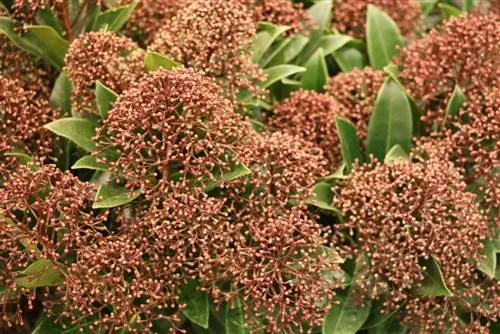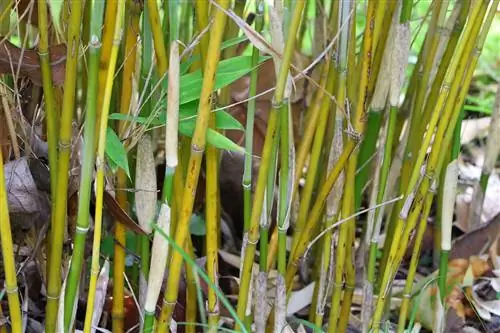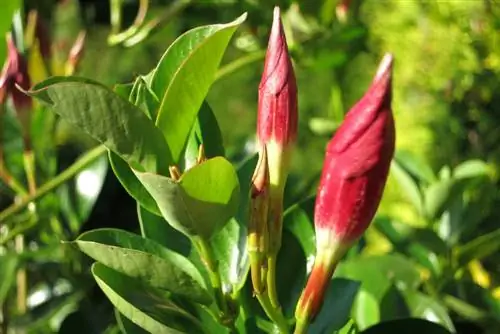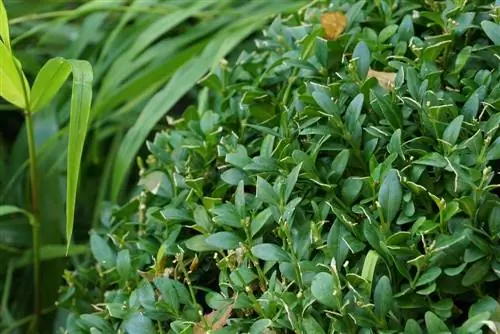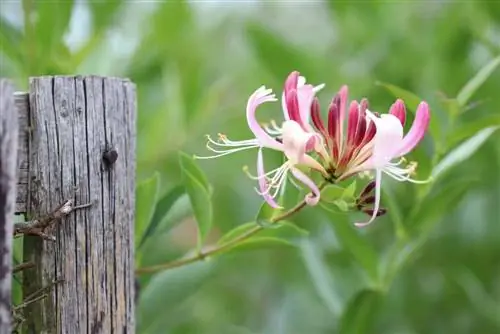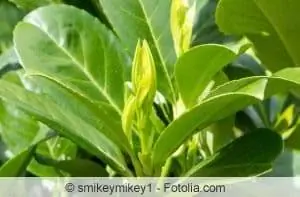- Author admin [email protected].
- Public 2023-12-17 03:39.
- Last modified 2025-01-24 12:45.
It looks different on the terrace or balcony; potted plants are necessary here. Which plants are suitable as container plants and which of them are evergreen?
Evergreen potted plants
By selecting suitable potted plants, a green privacy screen on the terrace or balcony can be easily created. Even where there isn't much space available, this is possible because there are small, medium and large potted plants. Basically, you should keep in mind that the pot for the potted plant:
- should be firm and have drainage holes
- not made of copper
- be big enough, but not too big
- frost and weather resistant
- should be suitable for non-hardy plants for winter quarters
When choosing, however, you don't have to limit yourself to the selection of vessels that are usually available for purchase; alternatives can also be very attractive and decorative. As long as they meet the above requirements, there is nothing wrong with it.
Evergreen plants are generally not flowering plants. But even a large hydrangea can help make a privacy screen even more beautiful. In its own way, its thick flower balls provide a beautiful and natural barrier, but it will not be sufficient as protection alone. But there are a number of beautiful other plants that are both tall enough and evergreen.
- Barberry (Berberis candidula), height 100-300 cm
- Olive willow (Elaeagnus x ebbingei) height 150-250 cm
- Climbing spindle bush (Euonymus fortunei), height 20-100 cm
- Shrub ivy (Hedera helix), height 150-200 cm
- Japanese pod (Ilex crenata), height 200-300 cm
- Skimmia (Skimmia japonica), height 50-150 cm
The cherry laurel and the rhododendron bush are very popular. With its flowers, which come in different colors depending on the variety, it also offers a very beautiful sight as a highlight.
There are also a variety of evergreen potted plants that are not yet well known. Conifers can also be planted in pots, as long as they are small specimens. If the green privacy screen is to be supplemented with flowering potted plants, these shrubs could be included in the selection:
- Ornamental quince (Chaenomeles japonica)
- Pipe bush (Philadelphus varieties)
- Winter scented viburnum (Viburnum farreri)
- Noble lilac (Syringa hybrids)
- Pfaffenhütchen (Euronymus alatus)
How are the potted plants potted?
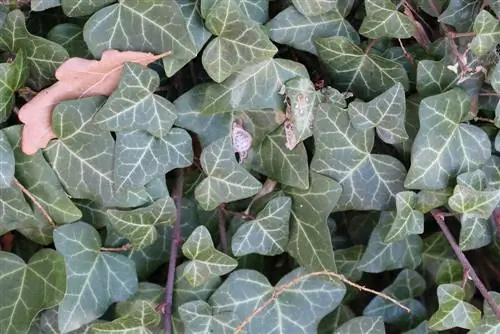
Since the potted plants are supposed to grow and thrive in a relatively cramped space, they need the right foundation for this. Basically, pots and containers should always be large enough without the plant looking lost in them. Especially at the beginning of growth, it will probably be necessary to repot the evergreen potted plants again, perhaps a second time, before they have found their final pot. After that, it is placed in a new pot with fresh soil every few years; the roots may then also have to be cut back.
First of all, however, it should be given the right soil so that it can grow and continue to grow well. It makes sense to pay attention to good quality soil. To do this, follow this step by step:
- First there is a drainage layer in the pot, this consists of grit or pebbles.
- A fleece is placed on top so that the potting soil is not washed out.
- The potting soil itself should be very mild and have a humus-like consistency.
- The last layer should be a layer of mulching material (e.g. pine bark).
- When placing the plant in the substrate, make sure that it sits lower than the upper edge of the pot. When repotting it should be planted deeper than before. Then the soil around the plant is pressed firmly and watered sufficiently.
Tip:
A new clay pot should be left in water for a day before planting.
With potted plants, it is important to ensure that they do not fall over due to a sudden gust of wind or an autumn storm. Not only can the pot break, the soil that falls out can also cause trouble. If pots with evergreen plants are set up as privacy screens, it makes sense to anchor them well. To avoid drilling into the bottom of the terrace, the pots can also hold each other. This works very well with metal clamps or iron rods; if the pots are close together, they hold each other firmly. Buckets that stand on the house wall or fence can be attached there with a rope or chain.
Care for evergreen potted plants
Evergreen potted plants should remain in their location all year round. Privacy protection should also be provided in winter, which is why it is important to protect the plant in cold temperatures. The pot offers a large surface area for frost to attack, so it should not only be made of a frost-proof material, but also - rather the plant - should also be protected from the cold. Even in the cold season, the plant in the pot needs water; most potted plants do not freeze but dry out. Of course, you only water if it doesn't freeze, anything else would be pointless. However, as soon as the sun shines or the temperatures rise above freezing, some water should be given.
Another measure for overwintering potted plants is to protect the root ball from the cold. These materials are suitable for winter protection:
- Coconut mats
- Winter protection fleece
- Styrofoam
Styrofoam should serve as a base for the pot so that it is nicely warmed from below. Alternatively, a wooden plate can also be used. If the pot is on feet, you can also put a bubble wrap between them. A special winter protection fleece is wrapped around the pot and then keeps it frost-free. Frost-sensitive potted plants should be put away if possible. There are aids such as a sack truck or a roller board.
Tip:
Evergreen plants have year-round photosynthesis, so they need water.
If the evergreen potted plant has survived the winter well, it will be unpacked again in spring or put back in place if it was in winter quarters. Now it is important to check whether the soil has not yet been renewed or whether the pot should be larger. Before the growing season begins, the potted plant receives its first portion of fertilizer. This is then given until the next winter rest; flowering plants usually stop fertilizing towards the end of September.
More tips on evergreen potted plants as privacy screens
Potted plants can be used wonderfully as privacy screens, creating natural yet effective protection against prying eyes on the terrace or balcony. In addition, you can create a new small sea of flowers on the terrace or balcony every year using various potted plants as privacy screens. The selection of potted plants is enormous, so designing them is twice as much fun.
- Always very beautiful and especially recommended for beginners in hobby gardening is the beautiful mallow. It is considered very easy to care for and shines with its striking orange, red, yellow and white flowers.
- The daisy is also always popular, but it doesn't grow quite as tall. Therefore, it can only provide visual protection to a limited extent. Nevertheless, it quickly loosens up a stiff privacy screen.

If you place lower potted plants on small stools or build a small staircase, you can create a really colorful and varied privacy screen.
A particularly effective privacy screen can be created with potted plants such as bamboo. It grows quickly and tall and brings a little southern flair to the garden. Many different types of palm trees are also suitable for using potted plants as privacy screens
First and foremost, you have to know that potted plants need to be watered almost daily in midsummer. This is the only way to ensure that they grow beautifully and can do justice to their use as privacy screens. You should also know that there are some winter-hardy potted plants that can stay outside even in winter and form a privacy screen, but there are also potted plants that have to be brought indoors in the fall because they cannot withstand frosty temperatures.
If you don't have space in the basement or in a winter garden so that the potted plants can overwinter here, you should only choose winter-hardy varieties from the outset. There are also low-care and high-care potted plants. At this point you should consider how much time you want to invest in maintaining the natural privacy screen.

